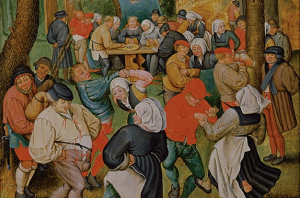Professor Catherine Davies discusses the world premiere of the Guildhall School‘s production of The Tale of Januarie. This project received support from the Arts and Humanities Research Council through the ‘Cross-Language Dynamics’ OWRI Project at the School of Advanced Study, University of London
 It’s not every day we have the chance to see a new opera and I had no idea what to expect in the Guildhall’s production of The Tale of Januarie. I knew the libretto, written in Middle English, was based on Chaucer’s unfinished The Merchant’s Tale, adapted by playwright Stephen Plaice. I knew the composer, Julian Philips, but I’d never heard his music. How would the opera be staged and performed? What would it look like, how would it sound? In the event, it was a gripping, sumptuous experience lasting three hours, a joy to hear and behold. The costumes, the lighting, the scenic effects, and above all the edgy music and singing, made this a memorable performance. Full credit is due to the director Martin Lloyd-Evans, conductor Dominic Wheeler, the orchestra and the singers, especially John Findon as old-man Januarie and Joanna Marie Skillett, his young bride, May. This is the story of a sex-obsessed Januarie who marries a pretty girl and is made a laughing stock when she deceives him with his handsome young servant. For the purposes of this blog, however, I want to draw attention to the complex interaction in the opera between music and text. What were the challenges and opportunities faced by Stephen Plaice when adapting Chaucer’s famous tale? How did Julian Philips match his music to a Late Middle English text? These questions form part of the AHRC’s Open World Research Initiative’s research project on modern languages, communities and translingual practices led by the IMLR.
It’s not every day we have the chance to see a new opera and I had no idea what to expect in the Guildhall’s production of The Tale of Januarie. I knew the libretto, written in Middle English, was based on Chaucer’s unfinished The Merchant’s Tale, adapted by playwright Stephen Plaice. I knew the composer, Julian Philips, but I’d never heard his music. How would the opera be staged and performed? What would it look like, how would it sound? In the event, it was a gripping, sumptuous experience lasting three hours, a joy to hear and behold. The costumes, the lighting, the scenic effects, and above all the edgy music and singing, made this a memorable performance. Full credit is due to the director Martin Lloyd-Evans, conductor Dominic Wheeler, the orchestra and the singers, especially John Findon as old-man Januarie and Joanna Marie Skillett, his young bride, May. This is the story of a sex-obsessed Januarie who marries a pretty girl and is made a laughing stock when she deceives him with his handsome young servant. For the purposes of this blog, however, I want to draw attention to the complex interaction in the opera between music and text. What were the challenges and opportunities faced by Stephen Plaice when adapting Chaucer’s famous tale? How did Julian Philips match his music to a Late Middle English text? These questions form part of the AHRC’s Open World Research Initiative’s research project on modern languages, communities and translingual practices led by the IMLR.
In the opening Q&A, chaired by Cormac Newark, Guildhall’s Head of Research, Stephen and Julian shared their creative experience. They emphasised the strange familiarity of Middle English – seemingly English but not quite, with its obvious Anglo-Saxon and Norman French roots jarring on modern sensibilities. Middle English, said Stephen, is like a foreign language you know fairly well, and writing Middle English was like writing two or three languages at the same time. It was a treat for him to work on the libretto, to create a final act in an unfinished tale, and to recreate the sense of fizz produced by the collision of the old and the new. For Julian, every single word in the libretto had to be weighed for its sound and its meaning, so that accents would fall in the right place, alliterations stressed, and the sonorous and highly coloured quality of the language maintained by the music. Elisions were important, eliding vowels as in Italian or German texts. Words ending in consonants, so unhelpful for singers, retain their final vowels in Chaucer’s English – so sickness is sicknesse, which gives the composer and singer scope for triple rhythm, sound and emotion. The composer can mine the text for its rhythmic qualities, for metric flow and tempo. For Stephen the challenge was how to keep the momentum of the strong narrative drive; for Julian the challenge was how to respond to the language in his music. Both agreed that Middle English had had a profound effect on the opera at every level: structure, rhythm, text and music all interacting in sympathetic dialogue.
To quote the programme notes, ‘Bringing Middle English to opera, a genre that didn’t exist when it was spoken, reveals how languages are never “dead”, that they still have unexplored colour and vibrancy’ and, I would add, can still communicate – especially when much can still be learned from Chaucer’s tales.
Catherine Davies, Professor of Hispanic and Latin American Studies
Director, Institute of Modern Languages Research

